This comprehensive guide tells you everything you need to know about bottom bracket standards, with a breakdown of all the bottom bracket systems available and their compatibility with one another.
But if you just want to know the basics, the bottom brackets 101 course in our explainer of what a bottom bracket is is a good place to start.
It wasn't long ago that the only major bottom bracket decisions you had to make were shell width, spindle length, and, in rare cases, English (BSA) or Italian threading. That simplicity is returning, but in the interim, bottom bracket babel has ruled, seemingly with as many 'standards' as there were bike brands, with every one of them supposedly being the best option.
Some of these different bottom bracket standards are still used on new bikes, while if you have an older bike, yours may use one of them. However, in general, newer bikes are designed to use either a BSA threaded, BB86/BB92 Pressfit or T47 bottom bracket.
If you want to get into the nerdy detail, here we run through each of the major bottom bracket systems available, along with advantages, disadvantages and notes on compatibility.
Every bottom bracket standard
Here's a quick list of all the different bottom bracket standards you might come across. Many are (thankfully) now obsolete, but you may still find them on older bike frames, so we've included them here for completeness.
- Conventional/BSA threaded
- BB90 and BB95
- PF86 and PF92
- BB30
- OSBB (road)
- BB30A and BB30-83 Ai
- PF30
- OSBB (mountain)
- PF30A and PF30-83 Ai
- BBRight
- BB386 EVO
- T47
- Threadfit 82.5
- SRAM DUB
Before we get stuck into the details of each standard, though, we've put together this helpful crib sheet that runs through all the key specifications.
Bottom bracket standards and compatibility
| BB Type | Proprietary? | BB Shell Inner Diameter | Bearing Inner Diameter | BB Shell Width | Installation | Compatibility | Other Names | Other Notes |
|---|---|---|---|---|---|---|---|---|
| ISO Threaded Internal | No | 1.37in x 24 TPI | N/A (integrated spindle) | 68mm road, 73mm MTB, 83mm DH, 100/120mm fat | Threaded internal bearings | Square taper, Octalink, ISIS | BSA / BS Threaded | Must match correct shell width & spindle length |
| ISO Threaded External | No | 1.37in x 24 TPI | 24mm (Hollowtech II), 24/22mm (GXP), 25mm (Ultratorque/Powertorque) | 68mm road, 73mm MTB, 83mm DH, 100/120mm fat | External cups | BSA / BS Threaded | External cups available for 30mm spindles | |
| Italian Threaded | No | 1.375in (34.92mm) x 24 TPI | 24mm (Hollowtech II), 24/22mm (GXP), 25mm (Ultratorque/Powertorque) | 70mm | External or internal | Can loosen itself (non-driveside is standard thread) | ||
| BB90/BB95 | Yes (Trek) | 37mm | 24mm | 90mm road, 95mm MTB | Pressed bearings with stepped shell | Designed for 24mm spindles, no 30mm option | Replaces cup width with frame real estate | |
| BB86/BB92 | No | 41mm | 24mm | 86.5mm road, 91.5mm MTB; others: 89.5mm, 104.5mm, 107mm, 121mm, 132mm | Bearings pressed in cups | 24mm spindles, some 30mm options | PF41 (Hope), PF24 (Chris King) | Non-proprietary version with looser tolerances |
| BB30 | No (open Cannondale) | 42mm | 30mm | 68mm road, 73mm MTB | 6806 bearings pressed into frame with circlips | BB30 cranks; 24mm step-down available | OSBB (Specialized) | Narrow width allows longer spindles with spacers |
| BB30A and BB30-83 Ai | Yes (Cannondale) | 42mm | 30mm | 73mm (BB30A), 83mm (BB30-83) | 6806 bearings pressed into frame with circlips | Asymmetric shell; wider non-driveside for support | ||
| PF30 | No (SRAM) | 46mm | 30mm | 68mm road, 73mm MTB | 6806 bearings in cups | BB30 cranks | Uses pressed cups for relaxed manufacturing tolerances | |
| PF30A and PF30-83 Ai | Yes (Cannondale) | 46mm | 30mm | 73mm (PF30A), 83mm (PF30-83) | 6806 bearings in cups | Press-fit version of BB30A and BB30-83 | ||
| BB386EVO | No (FSA) | 46mm | 30mm | 86.5mm (road) | 6806 bearings in cups | 386EVO & external BB cranks | Wide bearing spacing with 30mm spindle | |
| BB392EVO | No (FSA) | 46mm | 30mm | 91.5mm (MTB) | 6806 bearings in cups | 386EVO & external BB cranks | MTB version of 386EVO | |
| T47 | No (Chris King & Argonaut Cycles) | M47 x 1 | 30mm | 68mm road, 73mm MTB | Threaded cups with bearings | Cross-compatible depending on spindle length | Thread Fit 30i | Oversized BSA aiming to prevent press-fit creaks |
| Thread Fit 82.5 | Yes (Colnago) | 41mm (when shell is fitted) | 24mm (30mm) | 86.5mm (road) | Threaded shell + BB86 cups | BB86 cranksets (CeramicSpeed 30mm option) | Replaceable shell; optional integrated 30mm system |
Bottom bracket standards: features, pros and cons
Next, we'll run through the pros and cons of different bottom bracket standards.
Conventional/ISO/BSA threaded bottom brackets

Modern, external cup threaded bottom brackets are among the most common of standards. Square-taper bottom brackets also fit in most shells designed for external cup bottom brackets, but to keep things simple, we will only cover the modern standard here.
The idea is simple: by moving the bearings outboard of the shell, you can use a much larger spindle. Shimano popularised the concept as Hollowtech II, with a 24mm axle diameter the accepted norm compared to square-taper's relatively small 17mm diameter.
External bottom brackets for 30mm spindles exist, such as those from White Industries, enabling modern 30mm-diameter axle cranks to be used. Although BSA is the predominant standard, some brands (we're looking at you Pinarello) continue to use Italian threaded bottom bracket shells.
Threaded bottom brackets offer wide compatibility with different cranksets and avoid the creaking that can beset press-in bearings. Press-fit bearings need an expensive bearing press to install and remove, whereas threaded bottom brackets can be installed and removed with a few simple multi-purpose tools.
It's also possible to reface the bottom bracket shell, which can't be done with a press-fit design because it's reliant on the frame being made to close tolerances.
- Pros: Easy at-home service; interface surfaces can often be machined; huge selection of parts and accessories
- Cons: Heavier than press-fit systems; frame design limited by relatively small-diameter and narrow shell
- Crank designs that will fit: Standard 24mm external type (Shimano Hollowtech II, SRAM GXP, Campagnolo Ultratorque and Powertorque, FSA MegaExo, Race Face X-Type, etc), square taper, ISIS, BB386EVO, BB392EVO, many others. Crucially, external cups that fit 30mm spindles exist.
BB86 and BB92 bottom brackets
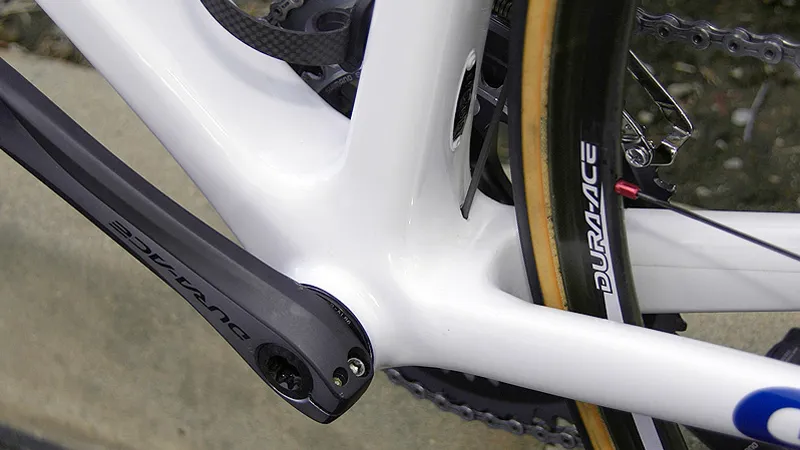
BB86/BB92 is a press-fit standard used by Scott, Giant, Pivot and many others.
The bearing diameter and location are identical to those of conventional threaded bottom brackets, only they're mounted in small composite cups before being pressed into the frame.
The advantage is a wider bottom bracket shell that can be more rigid and provide extra room for wider tyres. It doesn't otherwise affect crankset width, plus it's lighter in weight compared to threaded alloy cups.
The road standard has an 86.5mm shell width (hence BB86) whilst the mountain bike standard has a 91.5mm shell width. A number of other shell widths may also exist, although they all use the same bearing cups.
This system has had a number of names and is also called PF86 and PF92, as well as PF41 by Hope and PF24 for Chris King's discontinued bottom brackets. Trek used to use a variant of the system, BB90 and BB95, on its road and mountain bikes respectively, while Colnago used to use its own system called Threadfit 82.5, which threaded cups into an 86mm-wide shell rather than pressing them in.
- Pros: Lighter than conventional setups but retains compatibility with 'legacy' cranksets; creates a wider BB shell without affecting crank width
- Cons: Can't use cup-mounted chain guides; shell is wider but still small in diameter; requires a separate bearing puller and press for service, bearing bores can wear out and loose tolerances
- Crank designs that will fit: Standard 24mm external-type, 30mm spindle bottom brackets are available for, eg: BB386 EVO, BB392EVO
BB30 and OSBB bottom brackets
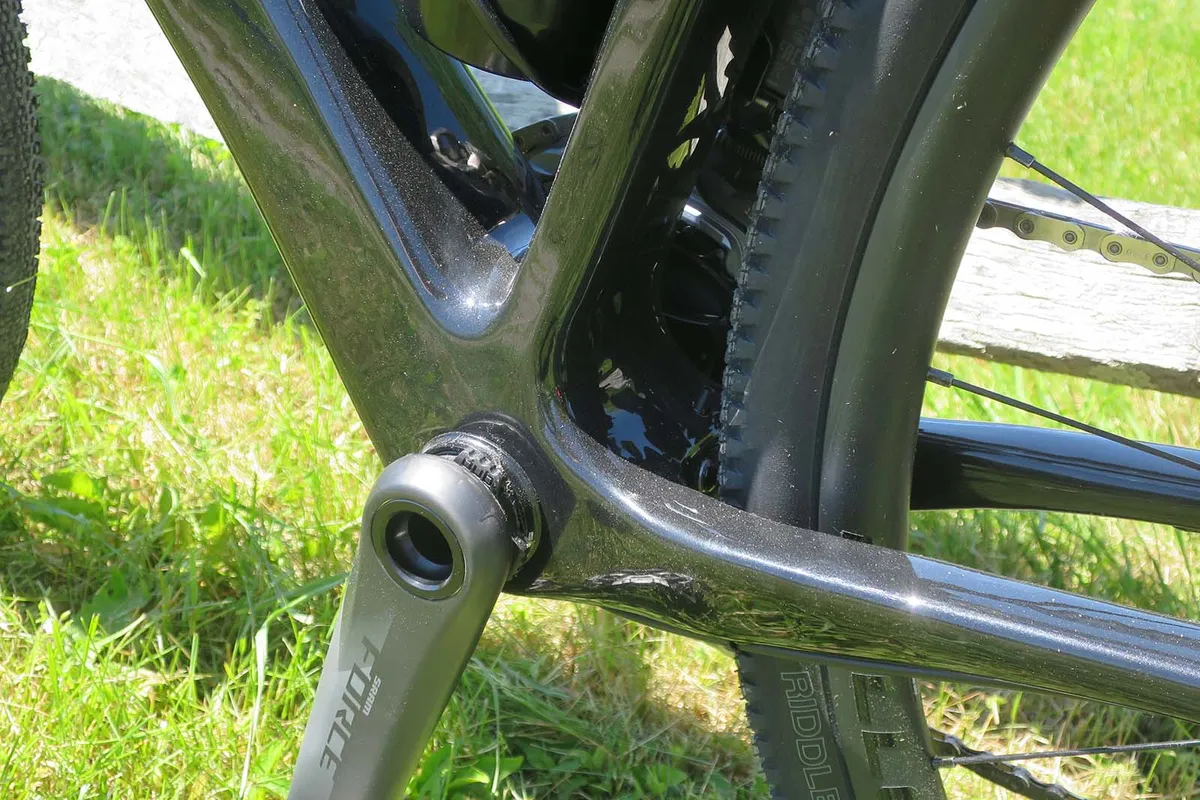
Several companies have dabbled in alternative bottom bracket standards over the years (Gary Fisher, Klein, and Merlin, to name three), but it wasn't until Cannondale released its then-proprietary BB30 system as an open standard in 2006 that something stuck.
BB30's bearing cartridges press directly into a precision-fit shell — albeit with the additional aid of two pairs of snap-rings/C-clips.
But here, it's the shell and spindle diameters that increase in size, not the shell width.
The key benefits are lighter weights owing to the larger, 30mm-diameter aluminium spindle and the elimination of separate bearing cups. Plus, because the shell is still only 68mm wide, the cranks can be made to provide more heel clearance — or, depending on the crank design, an even narrower stance width (commonly referred to as Q-factor).
BB30 shells, however, require more stringent dimensional tolerances to work well, meaning they're more expensive to manufacture. Moreover, BB30 also usually employs an alloy shell insert that has to be bonded or co-moulded into an otherwise carbon frame.
Specialized used to use the system (and PF30, below) on its bikes, but called it OSBB (over-size bottom bracket).
There's also a variant of BB30 called BB30a used on some older Cannondale bikes, which adds 5mm width on the non-driveside of the shell, which was designed to offer better support for the bearings, although it means some cranks aren't compatible. Yet another short-lived standard was BB30-83 Ai, with an 83mm-wide shell.
- Pros: Lighter; more resistant to axle twist; more heel clearance; larger-diameter shell and spindle; potential for narrower pedal stance width
- Cons: Shell still only 68mm wide; metal-on-metal interfaces can be prone to creaking; requires a bearing puller and press for service; requires high manufacturing tolerances; bearing seats can't easily be faced post-manufacturing
- Crank designs that will fit: BB30, BB386 EVO, standard 24mm external-type, Specialized OSBB, BBRight. Can be adapted to almost any standard with suitable adaptors.
PF30 and OSBB bottom brackets
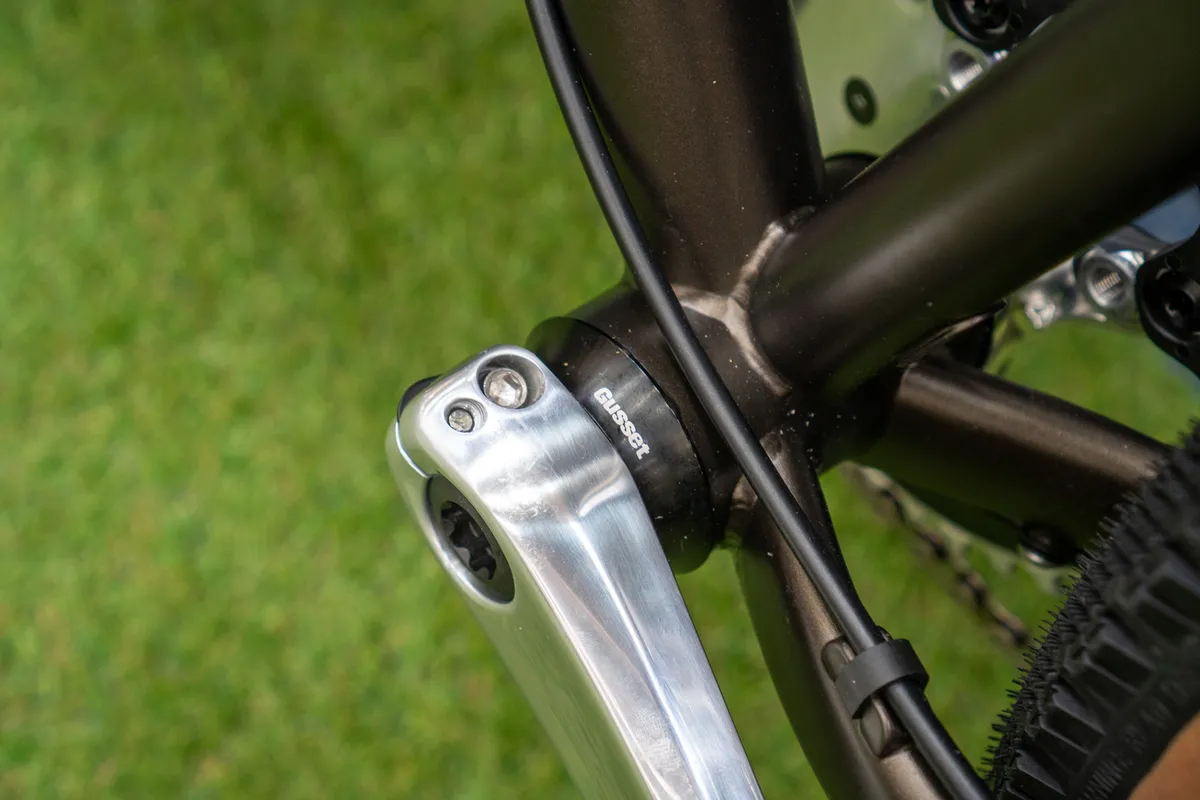
PF30 is analogous to BB30 in that the bearings and bearing locations are identical, but with the addition of intermediary composite cups that allow for looser frame tolerances. Not surprisingly, then, PF30 gained widespread traction in the industry, particularly with smaller manufacturers who can't afford high reject rates.
- Pros: Same as BB30 but with lower costs, easier assembly and the potential for additional bearing seals integrated into the cup/bearing assembly
- Cons: Standard-width shell; requires a cup remover and press for service
- Crank designs that will fit: BB30, BB386 EVO, standard 24mm external-type, Specialized OSBB, BBright
BBright bottom brackets
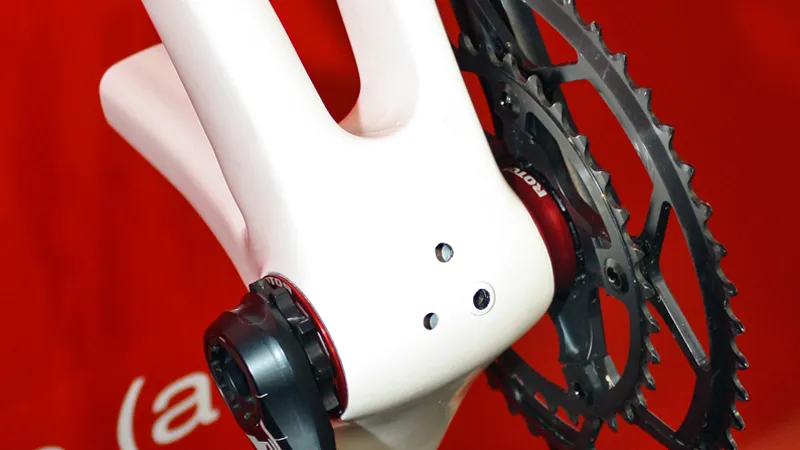
Most bottom bracket fitments incorporate bearings that are positioned symmetrically about the frame's centreline. Much like the Cannondale design, Cervélo tipped that apple cart in 2010, however, with the introduction of BBright.
BBright shares its 30mm-diameter alloy spindle, cartridge bearings and driveside bearing location with PF30 – in fact, the bottom bracket cups are identical to PF30.
However, the non-driveside bearing is pushed outward by 11mm – the same as conventional threaded PF86 bottom brackets. This makes it something of a hybrid between the two widely accepted systems.
BBright uses removable bottom bracket cups, similar to PF30. From the outset, Cervélo introduced BBright as an open standard that anyone could jump onto. While it seems to make good engineering sense, however, it's pretty much Cervélo-only.
- Pros: Stiffer than BB/PF30, in theory, without impacting other attributes; good crank compatibility; cheaper to manufacture than threaded or BB30
- Cons: Questionable longevity; requires a separate cup remover and press for service
- Crank designs that will fit: BBright, BB386 EVO, standard 24mm external-type
BB386 EVO & BB 392 EVO bottom brackets
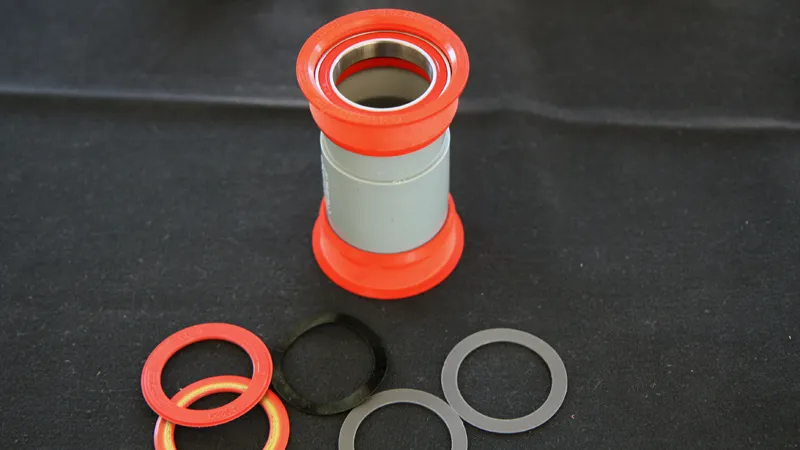
BB386 EVO and BB392 EVO, introduced in 2011, took the oversized principle to extremes. The bearings have the same 86/92mm spacing, width-wise, as conventional threaded external BB, BB90/95 and PF86/92 formats, but use BB/PF30's bigger 30mm-diameter spindle.
Because stiffness is tied directly to cross-sectional size, it's no surprise that, theoretically, BB386 EVO has the most to offer, with both the added shell width and diameter that many frame-makers yearn for.
In addition, it uses the same bearings and cups as PF30 and BBright and, thus, the same manufacturing tolerances and required tools.
Crank compatibility was another BB386 EVO strong point. Despite the bulbous dimensions, the shell will accept most modern crankset fitments save for dedicated BB30/PF30 and BBright designs. The straighter arms had less ankle and heel clearance than those narrower formats and the longer spindle wasn't as stiff, though.
In practice, it's another legacy standard that's rarely, if ever, seen on new bikes.
- Pros: Theoretically the best in terms of frame stiffness; reduced manufacturing costs; generous crankset versatility
- Cons: Heel clearance isn't as good as BB30; requires a separate cup remover and press for service
- Crank designs that will fit: BB386 EVO/BB392 EVO-specific, standard 24mm external-type (can be adapted), BBright, BB30 (axle-width dependent)
T47 bottom brackets
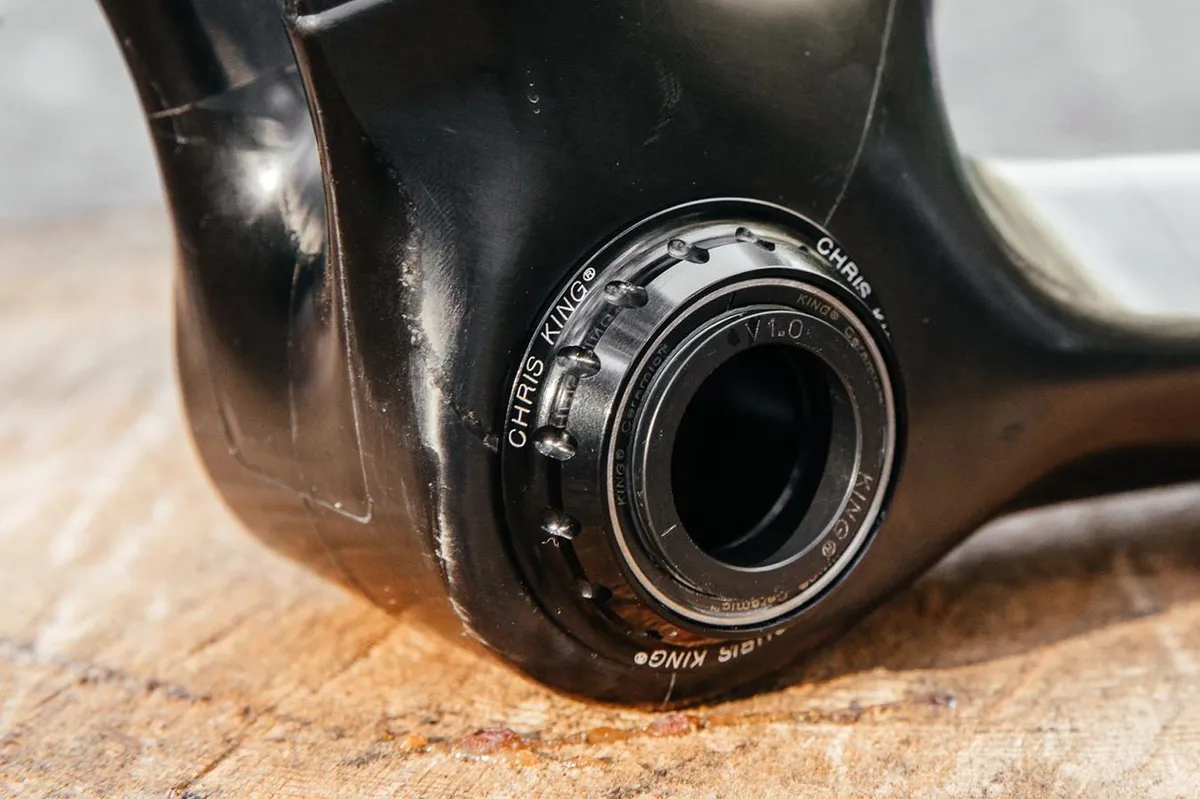
The last gasp for new bottom bracket standards came in 2015, with T47 designed as a collaboration by Chris King and Argonaut Cycles. Unlike some of its predecessors, T47 has caught on, and you'll find it in many modern frames. It uses the same 46mm internal diameter as PressFit 30, but the bearings thread into the frame rather than being pressed in.
This standard has also sometimes been known as Threadfit 30i.
The design aims to remedy the creaking issues associated with oversized press-fit systems. While these issues are nearly always the result of poor tolerances, the T47 standard promises to fix the creaking issue without sacrificing the benefits of an oversized interface.
The need for a heavier metal interface looked like a limiting factor for mass-produced carbon bikes, but with manufacturers including Trek now on board, that's largely been overcome.
- Pros: Vast crankset compatibility; open standard; threaded design easy to service and prevent from creaking; same dimensions as PF30
- Cons: New tooling needed for manufacture; requires metal threads; weight
- Crank designs that will fit: All (dependent on axle width)
SRAM DUB bottom brackets (Durable, Unifying Bottom Bracket)
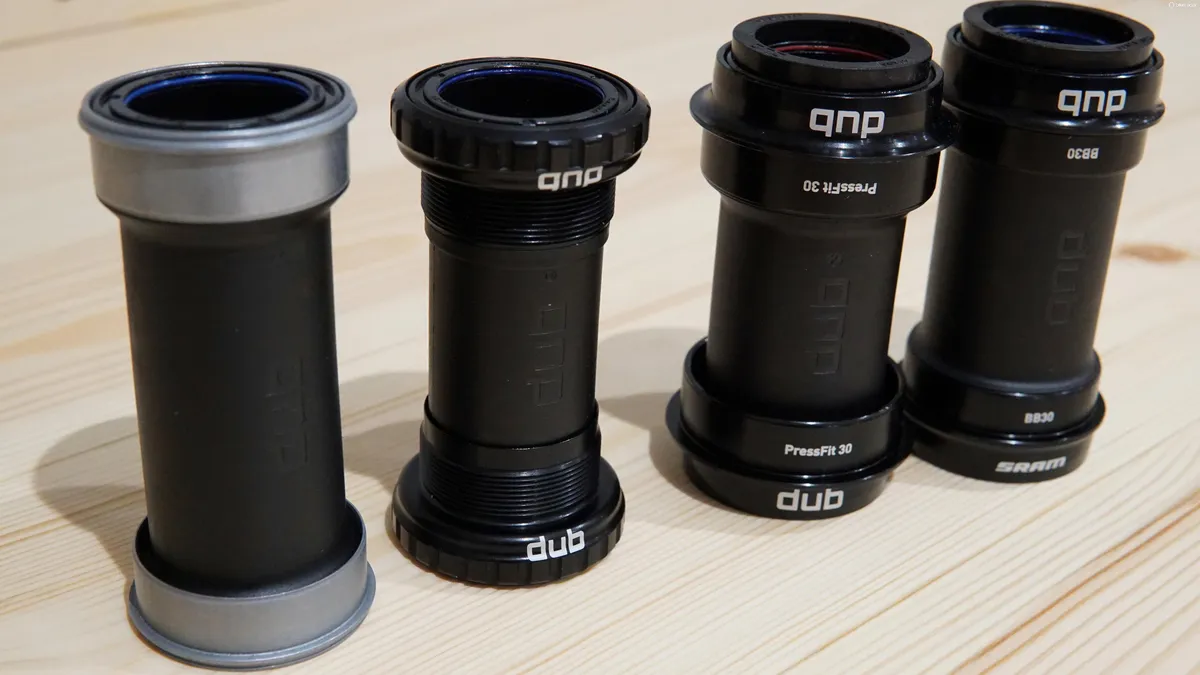
DUB (Durable, Unifying Bottom bracket) may sound like a new standard, but really it’s a new axle-diameter specification for road and mountain bike cranks.
SRAM claims the focus on optimising the bearings resulted in a spindle diameter of 28.99mm. This places it right between SRAM's old 24mm GXP cranks and 30mm spindles of modern cranks.
Thankfully, DUB has been designed with major bottom bracket standards in mind, enabling the cranks to be fitted to the most common designs with the choice of the appropriate bottom bracket.
DUB is compatible with BSA threaded, PF86, PF92, BB30 (73mm shell) and PF30 (73mm shell) bottom brackets, and cranksets are completely interchangeable between the different standards.
This is achieved by placing the bearings at the same axial location along the bottom bracket axis – in the case of BB30 and PF30 bottom brackets, that results in the bearings being located outboard of the frame.
- Pros: Claims of improved sealing and durability; compatible with major BB standards; cross-compatibility for DUB cranksets
- Cons: Proprietary system
- Crank designs that will fit: DUB
Will my cranks fit my bike?

While cranks designed specifically for your bottom bracket will fit, at some point you may want or need to adapt ‘non-standard’ cranks to your bottom bracket. It’s hard to confirm compatibility without looking at the specific combination of crankset and bottom bracket, but there are some rules of thumb we can apply.
Generally, your replacement cranks may have the same or smaller spindle diameter, and the same or longer spindle length than the system your bottom bracket is designed around.
For example, a BB30/PF30 bottom bracket has the narrowest shell width of any of the standards, while being designed for large 30mm spindles. That means it should be able to take most cranks with appropriate adaptors and spacers to take up the ‘space’ of a narrower and/or longer spindle.
However, it’s worth bearing in mind that using a stack of spacers may not be the optimum solution for performance (read stiffness) and reliability.
On the other hand, a BB30 crankset, being designed specifically for a BB30 bottom bracket, is generally not adaptable to many other systems, due to the short spindle length matching the narrow shell width. Newer BB30 cranks have started using longer spindles to make them a bit more versatile.
At the other end of the spectrum, Trek’s proprietary BB90/BB95 bottom bracket was designed around a wide shell and narrow spindle, meaning it was limited to traditional 24mm-spindle cranks.
Various other bottom bracket standards lie between these two extremes. Take these guidelines with a pinch of salt and always be sure to double-check what you can fit before committing to a new crankset.
How do I change to a different crankset?
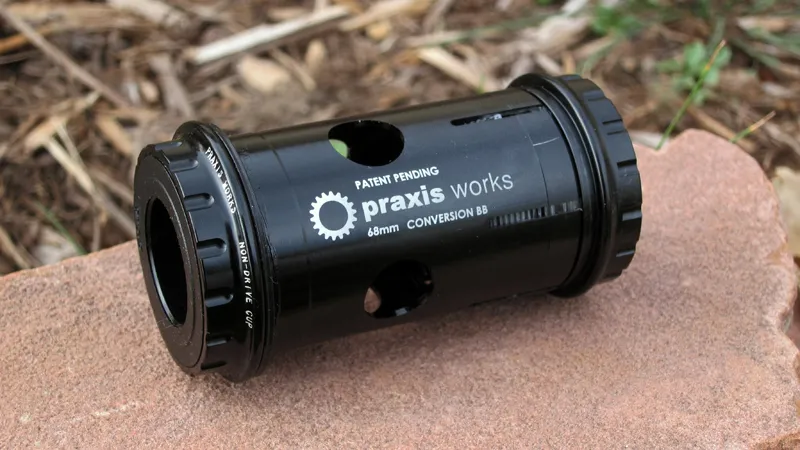
As you've probably noticed in the notes above, most of the bottom bracket standards offer a fairly wide range of options in terms of crankset choice. And, not surprisingly, several companies are at the ready to help you make those changes.
Current players in the mix-and-match field include Wheels Manufacturing, Rotor, Praxis, Enduro Bearings and even house brands of third-party distributors such as Quality Bicycle Parts' Problem Solvers.
Changing between setups typically requires some type of adapter. Or, in ideal cases, bottom bracket bearing assemblies that convert directly from one system to another, such as Praxis Works' BB/PF30-to-24mm assembly.
In general, though, the guideline is the same: try to minimise the number of parts involved. Having more parts added on top of each other results in greater tolerance stack-ups, plus more interfaces that could potentially creak and wear. Some converters are made of plastic, which isn't great for durability.
Why are there so many bottom bracket standards?

There's nothing wrong with threaded bottom brackets, per se, and it's worth noting that none of the proponents of alternative systems cast threaded systems as being completely flawed – that have been around for 100 years or so, after all. They do, however, note the system's inherent limitations in terms of frame design, which is why some companies continue to embrace non-threaded formats.
How companies decide to go about that – and precisely which design features they want – is the real issue, because everyone seems to have their own ideas on how to achieve the same goals (less weight, more stiffness and lower manufacturing costs).
"The explosion of bottom bracket standards reflects the various design objectives and manufacturing competencies of individual frame and component brands," says Eric Doyne, US PR representative for Shimano. "Shimano sees and values the importance for consumers to be able to easily source a frequent consumption article like the bottom bracket."
"The explosion of standards is not good for consumers or dealers," Doyne continues. "The bottom line is that bike companies are driving the standards. Threaded systems have very few limitations – they are easily cleaned and repaired at the shop level, and they do not affect the bearing fit."
In concept, at least, all of the standards we've covered are functionally sound. But the realities of tolerances and compatibility can create other issues.
For example, save for Shimano, Rotor, Specialized, and some FSA models that use adjustable effective crank arm-to-crank arm distance, most of these alternative systems require wave washers or compressible spacers to account for inherent shell-width variability (Magic Motorcycle used precision micro-shims back in the day, and some third parties offer similar systems for modern cranksets).
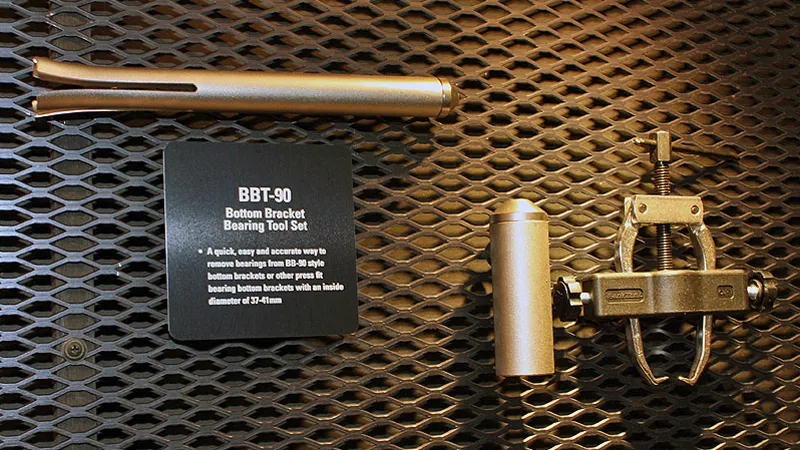
Things work OK if the installation is done correctly. But, if not, you could still end up with lateral play under load (possibly resulting in a dropped chain) or bearings that are too heavily preloaded (decreasing bearing lifespan).
Weather sealing can be a problem, too. Integrated cup and bearing systems at least have the potential for good barriers against dirt and moisture, depending on the design. However, bottom bracket standards that rely solely on bearings pressed directly into the frame sometimes have to make do with the typically inadequate seals on the bearing cartridges themselves.
Some designs even offer discipline-specific advantages. For example, BB30 offers the narrowest potential Q-factor, while wider shells allow for greater chainstay spacing, for more tyre clearance on mountain bike hardtails and gravel bike frames.
Finally, there are aesthetic considerations. Road companies often gravitate towards BB30 for the sleek, narrow form factor, while smaller builders dealing primarily in steel might prefer the more proportional look of a threaded shell. Carbon companies looking to maximise their stiffness (or stiffness-to-weight) figures generally just want to go bigger in some way.
As to which bottom bracket standard is 'best', the answer is undeniably straightforward: it depends.





